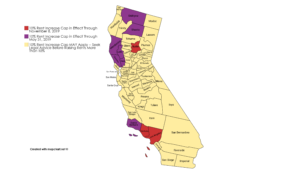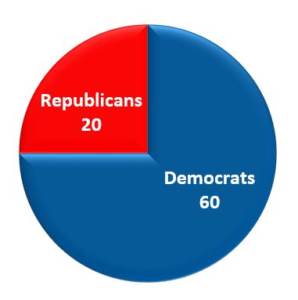Talk about a newsy year for California’s rental housing industry.
2018 brought the rise and fall of Proposition 10, some sensible approaches to the state’s housing shortage, and another round of devastating wildfires accompanied by protections against rent gouging.
Although last year is history, 2018’s biggest stories will continue to unfold in the months to come. In the paragraphs below, we focus on half-a-dozen rental housing stories with statewide implications — and make a few predictions to boot.
Statewide rent control proposals defeated
Without a doubt, the top rental housing story of 2018 was …
Without a doubt, the top rental housing story of 2018 was the defeat of Proposition 10 and AB 1506 — a pair of measures that threatened to bring extreme forms of rent control back to California by repealing 1995’s Costa-Hawkins Rental Housing Act.

In January 2018, AB 1506 received its first – and last — committee hearing in the Legislature. CAA and its allies provided lead testimony against the proposal, and over 400 rental property owners came to the microphone to indicate opposition to the measure. Following hours of testimony, AB 1506 lacked the needed votes to advance from the committee, rendering the bill dead for 2018 and assuring the safety, at least temporarily, of Costa-Hawkins, the most important landlord-protection law in California.
For more than 20 years, Costa-Hawkins has prohibited local governments from applying rent control to units built after 1995, as well as single-family homes, individually owned condominiums and townhouses. Costa-Hawkins also requires all rent control ordinances to allow a rental property owner to set the rent at market rate once a tenant moves out and a new tenant moves in, a policy known as vacancy decontrol.
While the defeat of AB 1506 marked a victory for CAA, it ushered in an even bigger battle for the rental housing industry, as tenant operatives shifted their energies to qualifying a statewide ballot measure to overturn Costa-Hawkins. By April, repeal proponents reported having collected more than half-a-million signatures, more than enough to qualify the initiative for the Nov. 6 ballot.
Anticipating a fight at the ballot box, CAA in the spring launched a campaign committee called Californians for Responsible Housing, which emphasized the detrimental effects that overturning Costa-Hawkins would have on California’s ongoing housing crisis.
CAA and its campaign committee, Californians for Responsible Housing, warned voters that repealing Costa-Hawkins would lead investors to abandon housing projects in California, exacerbating the state’s housing shortfall and further placing housing out of reach for working families.

Debra Carlton, CAA’s senior vice president of public affairs, reflected on the CAA-led No on Prop 10 campaign during the association’s New Laws Webinar, which members can access at no cost.
“You couldn’t turn on your television without seeing our commercials,” Carlton said. “We were able to demonstrate the very negative impacts in our local communities as it relates to housing construction.”
On Election Day, Prop 10 went down in overwhelming defeat, rejected by more than 60 percent of voters.
“But it was not an easy process,” Carlton said. “We had to raise quite a bit of money to defeat the measure and demonstrate the very negative impacts in our local communities as it relates to housing construction.”
Carlton forecasted further assaults on Costa-Hawkins and other attempts to expand rent control.
“While we successfully defeated Proposition 10, it’s not over,” she said, adding that a rent control measure already has emerged in the Legislature for this year.

Last month, Assemblyman Richard Bloom, who carried last year’s AB 1506, introduced a bill to stabilize rental prices. Although details are still lacking in this rent control bill, AB 36, CAA is monitoring its development closely.
The threat of another attempt to repeal Costa-Hawkins at the ballot box in 2020 also remains a possibility.
Before the election, Michael Weinstein, the main financier of the Prop 10 campaign, told the New York Times he would try again should the measure fail. “I’m kind of like gum on your shoe,” Weinstein said.
Wildfires cause devastation, trigger protections against rent gouging
2018 was another catastrophic year for California wildfires. After the Wine Country fires devastated the Santa Rosa region in 2017, wildfires raged again in Northern and Southern California over the past 12 months, bringing unprecedented destruction and loss of life. This past fall, the Camp Fire in Northern California’s Butte County destroyed more than 13,900 homes and killed 86 people, making it the deadliest wildfire in California history. Earlier in the year, the Mendocino Complex Fire burned 459,000 acres, making it the state’s largest fire on record.

Emergency declarations prompted by these fires and others, such as Southern California’s Hill and Woolsey fires, triggered the state’s anti-price-gouging protections, which prohibit raising the price of many consumer goods and services, including that of rental housing, by more than 10 percent above pre-emergency levels after an emergency has been declared. Protections against rent-gouging apply to existing tenants and at unit turnover.
In addition to newly triggered protections against price gouging, 2018 saw Gov. Jerry Brown extend several existing price-gouging bans connected with fires earlier in 2018 and in 2017.
At this point, California’s anti-price gouging protections are slated to remain in effect through May 31, 2019, for Lake, Mendocino, Napa, Santa Barbara, Shasta, Siskiyou and Sonoma counties. Protections against price gouging under state law also are in effect until Nov. 8, 2019, for Butte, Los Angeles and Ventura counties.
Although specific counties are named in the protection orders, enforcement of the state’s price-gouging ban does not stop at the county line. California’s attorney general has interpreted the price-gouging law to apply anywhere in the state with an increased consumer demand resulting from the emergency. Anyone convicted of violating the statewide anti-price-gouging law can face a year in county jail, a fine of up to $10,000, or both, as well as civil penalties. Local ordinances may impose additional penalties.
CAA urges landlords in counties named in declarations of emergency — and anywhere in the state — to seek legal advice before raising rents by more than 10 percent.
CAA also encourages members to review the association’s anti-price-gouging Industry Insight paper, which has been updated to address more frequently asked questions. The paper, Anti-Price Gouging Laws – States of Emergency, also addresses changes to the law under AB 1919, legislation that clarifies existing law.
Looking ahead, if destructive wildfires return to California in 2019, the state can expect further declarations of emergencies and corresponding protections against price gouging. Newly elected Gov. Gavin Newsom may also renew existing price-gouging bans tied to earlier fires. Improving the prevention and response to wildfires is an early priority for Newsom, who on his first day in office vowed to spend millions of dollars on the effort.
Members interested in helping fire victims can still find a list of ways to help on this CAA webpage and fire victims. To see examples of how the rental housing industry has already help fire victims, click here.
Democrats dominate in races for legislative, statewide offices
The Nov. 6 election in California marked a thorough rebuke of President Trump’s agenda, with Democrats winning significantly at every level of state government. CAA, however, worked to preserve a moderate voice at the Capitol.
Through its political action committees, CAA spent over $2.5 million directly and indirectly on candidates who understand and support the rental housing industry. CAA’s political program focused its resources on helping Republicans minimize losses and electing moderate, pro-business Democrats who value the rental housing business.
Democrats swept all statewide offices and won numerous Congressional, state Senate and Assembly seats. In the Senate, Democrats picked up three seats and Republicans lost three, giving Democrats a super majority of 73 percent with 29 Democrats and 11 Republicans.
This ratio hasn’t happened since the 1800s, so there’s a significant shift in terms of legislative balance of power. In the Assembly, meanwhile, Republicans lost five seats, giving Democrats a 60 to 20 advantage and gaining a 75 percent super majority.
The election also included Newsom’s landslide victory over Republican opponent John Cox.
With California moving its primary election to March in 2020, the election season will start quickly, making it more important than ever for CAA and its political programs to be engaged early.
Housing-supply remains priority, sensible proposals become law
In 2018, increasing California’s housing supply remained a priority for both CAA and the state Legislature. After the governor signed his highly anticipated housing package in September 2017, lawmakers built on that momentum and continued to author bills that make it cheaper and easier to construct housing while holding local governments accountable to build their fair share.
Brown signed a number of housing-supply proposals backed by CAA last year, including legislation that will add more apartments for low-income college students, streamline the approval process on land owned by Bay Area Rapid Transit, and help reform the way housing needs are calculated in order to meet local population growth.

California voters also did their part to address California’s housing shortage last year by approving Propositions 1 and 2 in the Nov. 6 election. CAA supported both measures, which together are expected to raise $6 billion, add much-needed affordable housing and help address the state’s homelessness crisis.
In the year to come, CAA will continue its work with lawmakers to advance sensible policy solutions to increase housing supply. Some positive bills have already emerged, including SB 50 by Sen. Scott Wiener, D-San Francisco. SB 50, a revised version of SB 827, which stalled at the committee level last year, would provide incentives for developers who agree to provide housing in “job-rich housing projects or a transit-rich areas.” Legislation to spur redevelopment and make it easier to add granny flats to residential lots also have been introduced.
Negative housing bills die in Legislature — or get fixed by CAA
In addition to derailing AB 1506, CAA was instrumental in stopping a number of onerous bills in 2018. In other cases, CAA vastly improved negative legislation before it was adopted.

One of the most threatening bills of 2018 was AB 2925 by Assemblyman Rob Bonta, D-Alameda. This bill would have imposed “just cause” eviction requirements across the state, making it more difficult and costly to evict bad tenants.
AB 2925 would have required rental property owners statewide to list a “cause” or a reason when deciding to terminate a tenancy. CAA led a grass roots campaign to kill this measure.
Another bill opposed by CAA, AB 2364, by Assemblyman Bloom, was originally written to expand the notice requirements and penalties for removing tenants under a law known as the Ellis Act, which allows landlords to exit the rental housing market. Although CAA secured significant amendments to this bill, it, too, died on the Assembly floor.
As originally written, a third eviction-related bill, AB 2343 by Assemblyman David Chiu, D-San Francisco, would have added about a month to an already-lengthy eviction process and have allowed tenants to pay rent in the middle of the month. Those provisions were all deleted from the bill thanks to dramatic changes secured by CAA.
As signed into law, AB 2343 extends two deadlines associated with the eviction process, effective Sept. 1, 2019. First, the law specifies that, when given a 3-Day Notice to Pay Rent or Quit or 3-Day Notice to Perform Covenants or Quit, tenants have three court days to comply, rather than just three calendar days. Second, the bill establishes that a tenant has five court days to file a response to an eviction lawsuit, rather than just five calendar days.
In the year to come, CAA expects a number of problematic proposals. In addition to Bloom’s rent control bill, legislation attacking the Ellis Act is likely to resurface in 2019.
“We’ve seen those bills introduced year after year, and we’ve successfully stopped those,” Carlton said. Before the Ellis Act, rent-controlled cities — Santa Monica in particular — were forcing landlords to stay in business, even if they were losing money or experiencing other hardships. The Ellis Act has blocked this type of government intrusion, providing a veritable escape hatch for owners who can no longer thrive – or even survive — in rent-controlled communities.
Updated Proposition 65 warnings take effect
A Proposition 65 “safe harbor” warning regulation that took effect Aug. 30 required many rental housing providers to post new signs about potential exposure to certain types of hazardous chemicals.
Under the changes, a new, specific type of Proposition 65 sign was required for property owners or management companies with 10 or more employees and an enclosed parking garage. New signs that meet the requirements are available from CAA.
![]()
![]() A new Proposition 65 sign also was required for such owners and managers with designated smoking areas on the property.
A new Proposition 65 sign also was required for such owners and managers with designated smoking areas on the property.
Following the warning instructions in these new regulations provides a “safe harbor” that complies with Proposition 65, a law enacted by voters in 1986 that requires businesses with 10 or more employees to provide warnings prior to exposing any person to chemicals that

cause cancer and or reproductive toxicity.
Since this warning methodology is not mandatory, a business may determine its own way to comply. The safe harbor, however, is the only way to be sure that a warning is in compliance without going to court.
The new “safe harbor,” which applies to all businesses and covers all potential-exposure chemicals listed by the state of California as causing cancer or reproductive harm, is explained in more detail in this Industry Insight paper. The new regulation differs from the prior regulation in that it requires the business to name a specific source of exposure and listed chemical – for example, inhalation of secondhand smoke and nicotine. Generic warnings no longer qualify for the “safe harbor.”
Another change, not yet finalized, will ultimately allow some property owners to take down Proposition 65 signs from locations other than enclosed parking facilities and designated smoking areas and instead include warnings in their lease agreements.
CAA requested this change as a specific regulation for the rental housing industry.
Heidi Palutke, CAA’s vice president of compliance and education, said she expects the state to finalize that change in mid-to-late 2019.
“Until that rental housing regulation is finalized, CAA recommends that you leave your signs up,” Palutke said, adding that landlords should continue to follow CAA prior warning guidance by also continuing to distribute CAA’s Prop 65 notice, which can be accessed through this Industry Insight paper.


